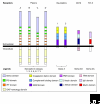The semaphorins
- PMID: 16584533
- PMCID: PMC1557745
- DOI: 10.1186/gb-2006-7-3-211
The semaphorins
Abstract
Semaphorins are secreted, transmembrane, and GPI-linked proteins, defined by cysteine-rich semaphorin protein domains, that have important roles in a variety of tissues. Humans have 20 semaphorins, Drosophila has five, and two are known from DNA viruses; semaphorins are also found in nematodes and crustaceans but not in non-animals. They are grouped into eight classes on the basis of phylogenetic tree analyses and the presence of additional protein motifs. The expression of semaphorins has been described most fully in the nervous system, but they are also present in most, or perhaps all, other tissues. Functionally, semaphorins were initially characterized for their importance in the development of the nervous system and in axonal guidance. More recently, they have been found to be important for the formation and functioning of the cardiovascular, endocrine, gastrointestinal, hepatic, immune, musculoskeletal, renal, reproductive, and respiratory systems. A common theme in the mechanisms of semaphorin function is that they alter the cytoskeleton and the organization of actin filaments and the microtubule network. These effects occur primarily through binding of semaphorins to their receptors, although transmembrane semaphorins also serve as receptors themselves. The best characterized receptors for mediating semaphorin signaling are members of the neuropilin and plexin families of transmembrane proteins. Plexins, in particular, are thought to control many of the functional effects of semaphorins; the molecular mechanisms of semaphorin signaling are still poorly understood, however. Given the importance of semaphorins in a wide range of functions, including neural connectivity, angiogenesis, immunoregulation, and cancer, much remains to be learned about these proteins and their roles in pathology and human disease.
Figures



References
-
- Yamada A, Kubo K, Takeshita T, Harashima N, Kawano K, Mine T, Sagawa K, Sugamura K, Itoh K. Molecular cloning of a glycosylphosphatidylinositol-anchored molecule CDw108. J Immunol. 1999;162:4094–4100. - PubMed
-
- Angelisova P, Drbal K, Cerny J, Hilgert I, Horejsi V. Characterization of the human leukocyte GPI-anchored glycoprotein CDw108 and its relation to other similar molecules. Immunobiology. 1999;200:234–245. - PubMed
-
- Bougeret C, Mansur IG, Dastot H, Schmid M, Mahouy G, Bensussan A, Boumsell L. Increased surface expression of a newly identified 150-kDa dimer early after human T lymphocyte activation. J Immunol. 1992;148:318–323. - PubMed
Publication types
MeSH terms
Substances
Grants and funding
LinkOut - more resources
Full Text Sources
Other Literature Sources
Molecular Biology Databases

